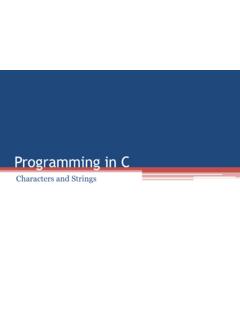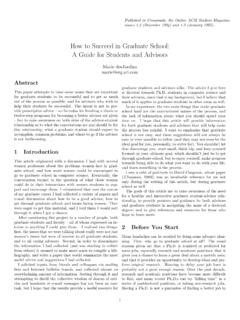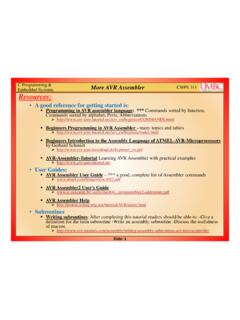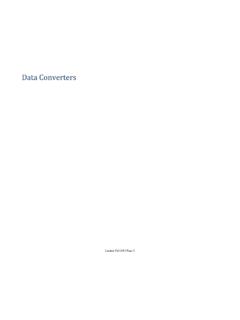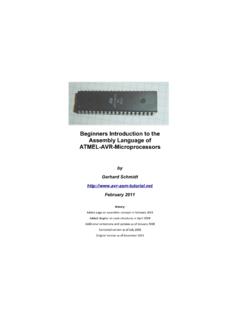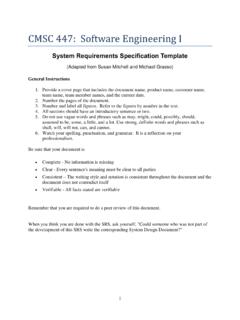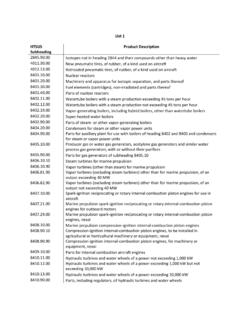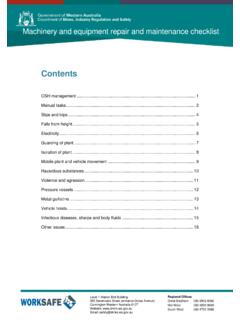Transcription of COMPUTING MACHINERY AND INTELLIGENCE
1 A. M. Turing (1950) COMPUTING MACHINERY and INTELLIGENCE . Mind 49: 433-460. COMPUTING MACHINERY AND INTELLIGENCE By A. M. Turing 1. The Imitation Game I propose to consider the question, "Can machines think?" This should begin with definitions of the meaning of the terms "machine" and "think." The definitions might be framed so as to reflect so far as possible the normal use of the words, but this attitude is dangerous, If the meaning of the words "machine" and "think" are to be found by examining how they are commonly used it is difficult to escape the conclusion that the meaning and the answer to the question, "Can machines think?" is to be sought in a statistical survey such as a Gallup poll. But this is absurd. Instead of attempting such a definition I shall replace the question by another, which is closely related to it and is expressed in relatively unambiguous words. The new form of the problem can be described in terms of a game which we call the 'imitation game.
2 " It is played with three people, a man (A), a woman (B), and an interrogator (C) who may be of either sex. The interrogator stays in a room apart front the other two. The object of the game for the interrogator is to determine which of the other two is the man and which is the woman. He knows them by labels X and Y, and at the end of the game he says either "X is A and Y is B" or "X is B and Y is A." The interrogator is allowed to put questions to A and B thus: C: Will X please tell me the length of his or her hair? Now suppose X is actually A, then A must answer. It is A's object in the game to try and cause C to make the wrong identification. His answer might therefore be: "My hair is shingled, and the longest strands are about nine inches long." In order that tones of voice may not help the interrogator the answers should be written, or better still, typewritten. The ideal arrangement is to have a teleprinter communicating between the two rooms.
3 Alternatively the question and answers can be repeated by an intermediary. The object of the game for the third player (B) is to help the interrogator. The best strategy for her is probably to give truthful answers. She can add such things as "I am the woman, don't listen to him!" to her answers, but it will avail nothing as the man can make similar remarks. We now ask the question, "What will happen when a machine takes the part of A in this game?" Will the interrogator decide wrongly as often when the game is played like this as he does when the game is played between a man and a woman? These questions replace our original, "Can machines think?" 2. Critique of the New Problem As well as asking, "What is the answer to this new form of the question," one may ask, "Is this new question a worthy one to investigate?" This latter question we investigate without further ado, thereby cutting short an infinite regress. The new problem has the advantage of drawing a fairly sharp line between the physical and the intellectual capacities of a man.
4 No engineer or chemist claims to be able to produce a material which is indistinguishable from the human skin. It is possible that at some time this might be done, but even supposing this invention available we should feel there was little point in trying to make a "thinking machine" more human by dressing it up in such artificial flesh. The form in which we have set the problem reflects this fact in the condition which prevents the interrogator from seeing or touching the other competitors, or hearing -their voices. Some other advantages of the proposed criterion may be shown up by specimen questions and answers. Thus: Q: Please write me a sonnet on the subject of the Forth Bridge. A : Count me out on this one. I never could write poetry. Q: Add 34957 to 70764. A: (Pause about 30 seconds and then give as answer) 105621. Q: Do you play chess? A: Yes. Q: I have K at my K1, and no other pieces. You have only K at K6 and R at R1.
5 It is your move. What do you play? A: (After a pause of 15 seconds) R-R8 mate. The question and answer method seems to be suitable for introducing almost any one of the fields of human endeavour that we wish to include. We do not wish to penalise the machine for its inability to shine in beauty competitions, nor to penalise a man for losing in a race against an aeroplane. The conditions of our game make these disabilities irrelevant. The "witnesses" can brag, if they consider it advisable, as much as they please about their charms, strength or heroism, but the interrogator cannot demand practical demonstrations. The game may perhaps be criticised on the ground that the odds are weighted too heavily against the machine. If the man were to try and pretend to be the machine he would clearly make a very poor showing. He would be given away at once by slowness and inaccuracy in arithmetic. May not machines carry out something which ought to be described as thinking but which is very different from what a man does?
6 This objection is a very strong one, but at least we can say that if, nevertheless, a machine can be constructed to play the imitation game satisfactorily, we need not be troubled by this objection. It might be urged that when playing the "imitation game" the best strategy for the machine may possibly be something other than imitation of the behaviour of a man. This may be, but I think it is unlikely that there is any great effect of this kind. In any case there is no intention to investigate here the theory of the game, and it will be assumed that the best strategy is to try to provide answers that would naturally be given by a man. 3. The Machines Concerned in the Game The question which we put in 1 will not be quite definite until we have specified what we mean by the word "machine." It is natural that we should wish to permit every kind of engineering technique to be used in our machines. We also wish to allow the possibility than an engineer or team of engineers may construct a machine which works, but whose manner of operation cannot be satisfactorily described by its constructors because they have applied a method which is largely experimental.
7 Finally, we wish to exclude from the machines men born in the usual manner. It is difficult to frame the definitions so as to satisfy these three conditions. One might for instance insist that the team of engineers should be all of one sex, but this would not really be satisfactory, for it is probably possible to rear a complete individual from a single cell of the skin (say) of a man. To do so would be a feat of biological technique deserving of the very highest praise, but we would not be inclined to regard it as a case of "constructing a thinking machine." This prompts us to abandon the requirement that every kind of technique should be permitted. We are the more ready to do so in view of the fact that the present interest in "thinking machines" has been aroused by a particular kind of machine, usually called an "electronic computer" or "digital computer." Following this suggestion we only permit digital computers to take part in our game.
8 This restriction appears at first sight to be a very drastic one. I shall attempt to show that it is not so in reality. To do this necessitates a short account of the nature and properties of these computers. It may also be said that this identification of machines with digital computers, like our criterion for "thinking," will only be unsatisfactory if (contrary to my belief), it turns out that digital computers are unable to give a good showing in the game. There are already a number of digital computers in working order, and it may be asked, "Why not try the experiment straight away? It would be easy to satisfy the conditions of the game. A number of interrogators could be used, and statistics compiled to show how often the right identification was given." The short answer is that we are not asking whether all digital computers would do well in the game nor whether the computers at present available would do well, but whether there are imaginable computers which would do well.
9 But this is only the short answer. We shall see this question in a different light later. 4. Digital Computers The idea behind digital computers may be explained by saying that these machines are intended to carry out any operations which could be done by a human computer. The human computer is supposed to be following fixed rules; he has no authority to deviate from them in any detail. We may suppose that these rules are supplied in a book, which is altered whenever he is put on to a new job. He has also an unlimited supply of paper on which he does his calculations. He may also do his multiplications and additions on a "desk machine," but this is not important. If we use the above explanation as a definition we shall be in danger of circularity of argument. We avoid this by giving an outline. of the means by which the desired effect is achieved. A digital computer can usually be regarded as consisting of three parts: (i) Store.
10 (ii) Executive unit. (iii) Control. The store is a store of information, and corresponds to the human computer's paper, whether this is the paper on which he does his calculations or that on which his book of rules is printed. In so far as the human computer does calculations in his bead a part of the store will correspond to his memory. The executive unit is the part which carries out the various individual operations involved in a calculation. What these individual operations are will vary from machine to machine. Usually fairly lengthy operations can be done such as "Multiply 3540675445 by 7076345687" but in some machines only very simple ones such as "Write down 0" are possible. We have mentioned that the "book of rules" supplied to the computer is replaced in the machine by a part of the store. It is then called the "table of instructions." It is the duty of the control to see that these instructions are obeyed correctly and in the right order.
